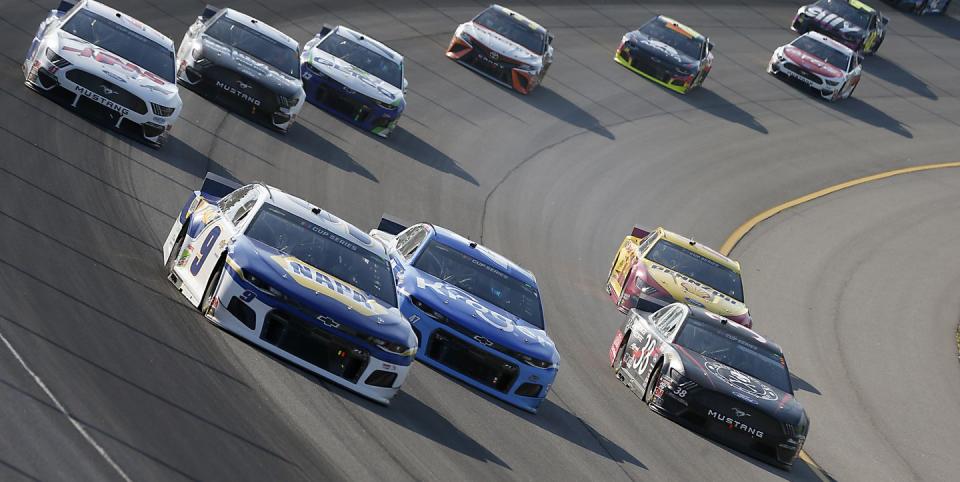Takeaways from the Firekeepers Casino 400 at Michigan

It was a good day for the choose rule.
Kevin Harvick won the Firekeepers Casino 400 at Michigan International Speedway on Saturday, and looked largely invincible in the process, but NASCAR’s new restart procedures kept things interesting until the very end.
First and foremost: Give credit to NBC Sports for clearly showing the lane selection before every restart. It’s challenging for fans to understand it when they couldn’t experience it, something supported by FOX Sports’ failure to show the rule during its unofficial debut last month during the All-Star Race at Bristol Motor Speedway.
The moment it seemed to click for most viewers is after Chase Elliott used it to take the lead on Lap 139. Elliott was running fifth before 'taking the cone,' short track vernacular for choosing the non-preferred lane, selecting the inside front row after the leaders each took the dominant outside line.
That means Elliott went from running fifth to lined-up second.
Elliott powered by Harvick with a push from Brad Keselowski and took the lead on a restart where he would have ordinarily taken the green third on the bottom.
That’s the beauty of the choose rule, a longstanding short track procedure that NASCAR drivers have been loudly advocating for in recent years, but especially over the past two seasons with the current high downforce, low horsepower rules package.
The current formula makes restarts more important than ever before, and it becomes especially challenging to pass once cars get single-file due to the giant spoiler affixed to the rear of these cars, and the lack of power to overcome it.
Thus, the choose rule permits a driver who doesn’t have track position, should the opportunity present itself, to bet on himself in the non-preferred line and try to get clean air by force.
Kyle Busch used it on Lap 148 to take the lead, after he 'took the cone,' to go from the third position to the inside front row after Elliott and Harvick took the outside. Without the choose rule, Busch would have started on the bottom of the second row.
Of course, Busch didn’t have race winning speed, but took the lead regardless. That made things even more compelling when Harvick drove right up to his rear bumper and forced the No. 18 aero loose and into the wall.
Action!
Ultimately, the rule works because it places an additional layer of strategy into the drivers’ hands. No longer can a driver blame their lack of success on the randomness of which lane they happened to restart in during the course of the race.
Was it kind of strange to make a procedural change right in the middle of the season? Sure. There’s also several precedents for it, between double-file restarts, not racing back to the line after a caution and swapping from a wing to a spoiler on the Car of Tomorrow.
Better to do it now, rather than after the start of the playoffs, especially if there is widespread optimism that it can make the racing more compelling.
Mission accomplished through one race at Michigan.
THE CASE FOR SHORTER RACES
This will prove to be an unpopular opinion in some circles, but Saturday’s Firekeeper Casino 400 at Michigan International Speedway was the perfect length and tempo for a modern NASCAR Cup Series race.
Let’s just get this out of the way: The cars are too reliable, and its drivers are too physically fit to make 500 miles the test of man and machine that it was back in the golden era.
Saturday’s race at Michigan was a 322-mile affair that lasted 2 hours and 35 minutes, providing just as much action as the standard 400-mile event, with considerably less filler and more urgency.
Shorter race, extra restarts, tons of variables. When spotter says “4-5 wide” and we didn’t get damage, I will take that any day! We know we can be better. pic.twitter.com/66TyacyWl4
— Kurt Busch (@KurtBusch) August 9, 2020
The pushback, of course, is that attending fans spend too much money to be short-changed a return on their investment. But consider the following: Saturday’s race was 78 miles shorter but finished just 20 minutes shorter than both its 2018 and 2019 counterparts.

Did anyone feel hoodwinked out of their NASCAR experience on Saturday, especially knowing there is another scheduled for Sunday?
Drivers never had a chance to ride around and just log laps, especially with a random draw that determined the starting lineups, and stages that ended on Laps 40 and 85 respectively. There was immediate and continued urgency.
Pocono Raceway already had a scheduled doubleheader for the 2020 season, with Michigan and Dover inheriting the same format due to the pandemic. The shorter races proved successful at Pocono, and the first Michigan twin delivered as well.
Here’s to hoping future NASCAR Cup Series schedules include more Saturday-Sunday doubleheaders. For those attending in person, you’re getting two (albeit shorter) races for the price of one, and perhaps included a companion race to extend the day and offering a return on the investment.

 Yahoo Autos
Yahoo Autos 